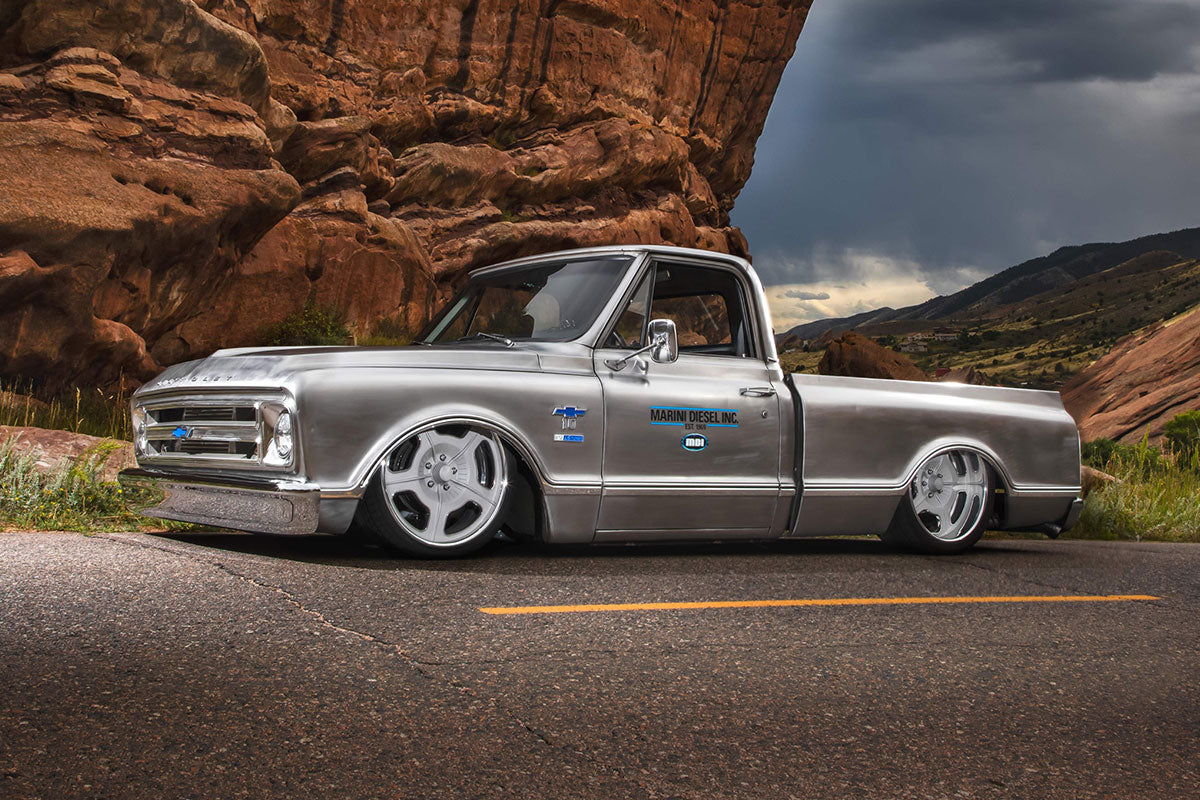Truck Air Suspension Systems - Everything You Need To Know

When it comes to air suspension for trucks, there are two ways to look at it - bagging a truck or using air suspension for towing. Air suspension is a great way to customize your truck and make it more efficient for those who haul and tow. While these seem similar, they are actually quite different and will require different components for each setup. For this article, we are going to break it down into two parts to make it easier to understand what you may need.

Air Suspension For Bagging A Truck
First we are going to look at truck air suspension for bagging your truck. What this means is that you are using an air suspension system to raise and lower your truck to get your truck to a certain height. This is mainly used for show purposes where most truck owners “lay out” or “lay frame.” These are slang terms for airing out your suspension to where the truck’s frame is on the ground when the air suspension is completely deflated.
What You Will Need To Bag A Truck
When bagging your truck, you are going to need a high-quality air suspension system. This is going to be a much longer list than those looking to add air bags to help with towing as you will be installing a full air suspension kit on all four corners. We here at AccuAir have put together a quick list of everything you will need for your air suspension system:
Air Compressor - As the heart of your air suspension system, a high-quality air compressor is needed to pump air through your system. Air compressors pull in air and compress it to store in your air tank. Depending on your setup, you may need two air compressors to keep your air tank filled to meet the demands of your system.
Air Tank - The air tank in your air suspension kit is going to be where all of your compressed air is stored. These come in 3 gallon and 5 gallon configurations and the size you need will depend on the amount of times you air out. For trucks, we usually suggest a 5 gallon air tank to be on the safe side.
Air Lines - Air lines are the lines that carry air from your tank to the manifold and from the manifold to the air shocks. These air lines will run throughout your vehicle to reach from the manifold to each air shock and need to be mounted tucked away from any potential damage. We have a great guide on routing your air suspension lines that should be a great help.
Valve Manifold - A valve manifold for air suspension is a vital component of any air suspension system. The valve manifold electronically controls the air delivery in your system. It is usually made up of an aluminum block with electronic solenoids, valves, and ¼” fittings to allow for an easy installation. The biggest thing to look for here is whether you need a 2 or 4 corner unit, the quality of the manifold as it may be exposed to the elements, and the way that it connects to your system.
Management System - When dealing with an electrically controlled air suspension system, you are going to need a good management system to easily control your system. An air suspension management system will include everything you need to raise and lower your vehicle from your smartphone or through a controller (wired or wireless). AccuAir is the industry leader in providing air management solutions with our e-Level and e+ Connect systems.
Air Shocks - Air shocks are going to be quite similar to your factory shocks or struts. However, instead of coil springs, these shocks will be equipped with bladders that fill with air to raise your vehicle and deflate to lower your vehicle. These air shocks bolt into the same location as your OEM equipment and are quite easy to install. Simply bolt it into place and run your air lines to the top of the shock.
Water Traps/Filter - Since air suspension systems utilize air compressors, there is always the chance of moisture forming from the compressed air that is generated. Moisture can cause several issues in your air suspension system, so it is important to have a water trap or filter in your system. These traps/filters help to trap the moisture or water in your system before it reaches your air tank. This can save you time and money in the long run while ensuring your system runs at its best.
Ride Height Sensors - Last but not least, ride height sensors are a great upgrade for those wanting to take their air suspension to the next level. Height sensors allow you to set preset heights so that you can easily get to a certain stance at the press of a button. These can be added to your AccuAir kit or purchased separately as an upgrade.
Things To Consider
When bagging your truck, you will need to consider how low you want to go. On most trucks, if you are trying to lay frame, there is going to be some notching of your frame that will need to happen. This involves cutting out a piece of your frame where the axle hits when airing out. The frame can be reconnected with a piece of tubing similar to the frame in the shape of a C, referred to as a “C” notch. This allows the axle tubes to travel further and allows your truck to get lower.
Truck Air Suspension For Towing/Hauling
Air suspension on trucks that are designed for towing and hauling are used in conjunction with your factory suspension. These are usually referred to as “helper bags” as they help your truck tow large loads. These air bags help keep your truck level to reduce the strain on components such as your driveshaft and u-joints. These air bags are not designed to raise or lower your vehicle as much as air shocks, but can be used to raise your truck bed back up when loaded down.
What You Will Need For Air Suspension When Hauling/Towing
If you are wanting to add air bags to your truck to aid in towing or hauling, your parts list is less drastic than a full air suspension system. Most kits are going to come with a heavy-duty air bag, a bracket system, air line, a small air compressor, a controller, and all of the necessary installation components. These kits are very easy to install and can be completed by the average truck owner. Unlike full air suspension kits, you will not have to worry about large compressors, air tanks, or manifolds.
Things To Consider
When considering an air bag kit for your truck, you will need to make sure that the kit is compatible with your specific truck. Depending on your factory suspension setup, you may have to find the type of kit that works with your specific application. Before purchasing a kit, you will need to take into consideration the load-leveling capacity. Unlike air shocks, these air bags have load ratings that will dictate just how well they work for your type of towing or hauling.





Leave a comment